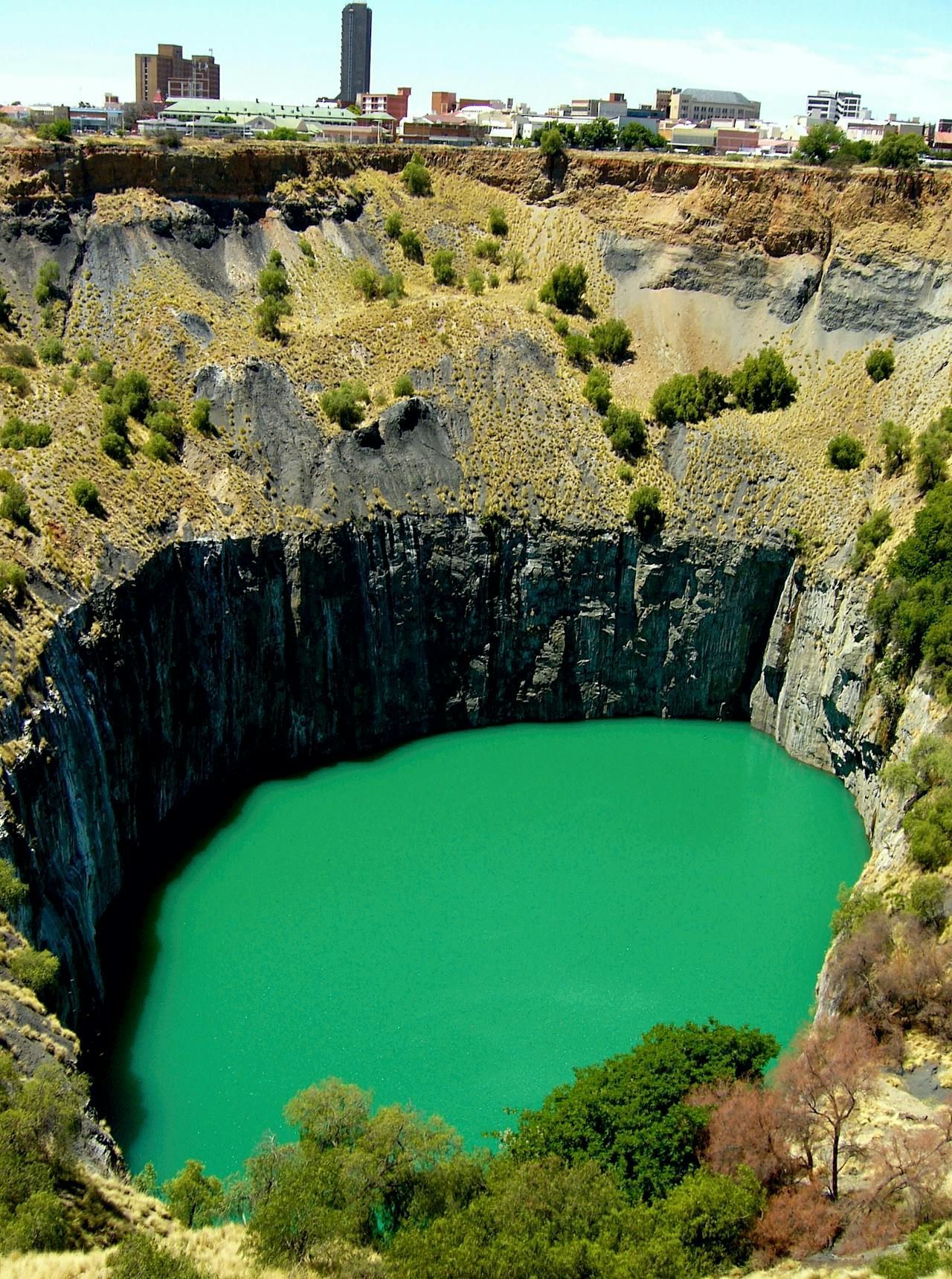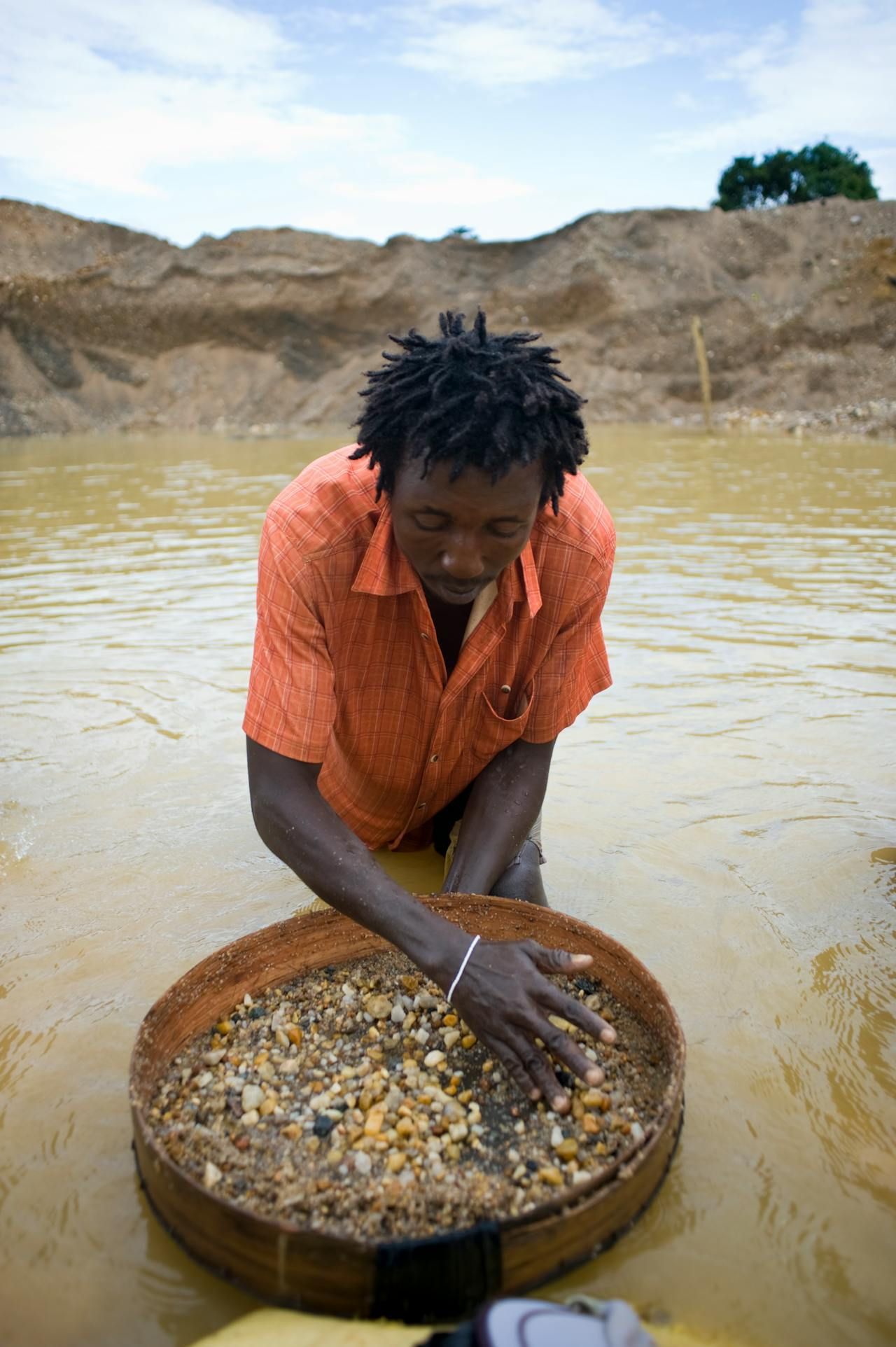Jonathan Goldberg is the Founder, President & CEO of Kimberfire – a brilliant way to buy diamond engagement rings, fine diamond jewelry, and loose diamonds in Toronto, ON and across Canada. Previously Jonathan worked in the Middle East, Belgium, and Canada in various roles in the luxury goods sector including manufacturing, business development, and diamond wholesale. Jonathan also spent a number of years as an investment banker with one of the large Canadian banks, where he focused on natural resources and diversified issuers.
Natural Diamonds' Positive Global Impact

Natural diamonds, formed over billions of years under extreme pressure and heat deep within the Earth's mantle, are not just symbols of luxury and romance but also remarkable feats of nature. These precious stones, composed of pure carbon, are renowned for their exceptional hardness and brilliance. The journey of a natural diamond, from a rough stone embedded in the depths of the earth to a polished gem adorning jewelry, is a testament to both nature's prowess and human ingenuity.
Exploring the Positive Global Impact of Natural Diamonds
While diamonds are often celebrated for their beauty and used as symbols of love and commitment, their story extends far beyond personal adornment. This article aims to shed light on the lesser-known, yet significant, positive impacts of natural diamonds on a global scale. From economic contributions and technological advancements to environmental stewardship and social development, the multifaceted benefits of the diamond industry play a crucial role in various aspects of global development.
The narrative around diamonds has not always been positive, with concerns over ethical sourcing and environmental impacts often taking center stage. However, recent strides in ethical practices, sustainable mining, and community development initiatives have begun to reshape this narrative. By exploring these positive contributions, this article seeks to provide a balanced and comprehensive understanding of the role natural diamonds play in our world today.
In the following sections, we will delve into the historical context of diamond mining, examine the economic and technological benefits, explore the environmental and social initiatives associated with diamond mining, and look at the future prospects and challenges of this industry. Through this exploration, we aim to present a holistic view of the natural diamond industry and its far-reaching impacts on our world.

Historical Context of Diamond Mining
Early History and Discovery of Diamonds
The fascination with diamonds dates back thousands of years, with the first recorded diamond discoveries in India around the 4th century BCE. These early diamonds were found in alluvial deposits of rivers and were revered for their strength and brilliance. Historically, diamonds were not just ornamental but also symbolized power, strength, and invincibility, often adorning the crowns and armor of royalty.
Evolution of Diamond Mining Techniques
Over centuries, the methods of diamond mining have evolved significantly. From the initial alluvial mining in riverbeds, the discovery of diamond mines in Brazil in the 18th century marked a shift to more systematic mining operations. The 19th century saw a diamond rush in South Africa, leading to the opening of the famous Kimberley Mine and the establishment of De Beers Consolidated Mines Limited. This period marked the beginning of large-scale, industrial diamond mining.
The 20th century brought further advancements with the introduction of open-pit mining and underground mining techniques. These methods allowed for the extraction of diamonds from deeper within the earth, significantly increasing the yield and efficiency of diamond mining operations.
Major Diamond Mines Around the World
The discovery of diamond mines has had a profound impact on various regions around the world. Some of the most notable include:
- The Kimberley Mine, South Africa: Often referred to as "The Big Hole," it was one of the first major diamond mines and played a crucial role in the global diamond industry's development.
- The Argyle Mine, Australia: Known for producing a high volume of diamonds, including rare pink and red diamonds, Argyle significantly contributed to the global diamond supply.
- The Diavik and Ekati Mines, Canada: These mines, located in the Northwest Territories, are known for their high-quality gemstones and stringent environmental standards.
- The Mirny Mine, Russia: One of the largest man-made holes in the world, the Mirny Mine is a testament to the scale of modern diamond mining operations.
These mines, among others, have not only contributed significantly to the global supply of diamonds but have also played pivotal roles in the economic and social development of their respective regions. The historical journey of diamond mining is a story of human endeavor, technological progress, and the transformation of natural resources into valuable assets that have shaped economies and societies across the globe.

Economic Contributions
Job Creation in Diamond Mining Regions
The diamond mining industry is a significant source of employment, particularly in regions where economic opportunities may be limited. In countries like Botswana and South Africa, diamond mining has created thousands of jobs, not only within the mining operations themselves but also in supporting industries such as transportation, equipment manufacturing, and service sectors. This employment has a multiplier effect, stimulating growth and providing livelihoods in local communities.
Contribution to National Economies
Diamond mining can be a major economic driver for countries with significant deposits. For instance, in Botswana, diamond revenues have transformed the country from one of the poorest in Africa to a middle-income nation. The revenues from diamond mining contribute significantly to national GDP, finance public services, and support infrastructure development. In a country like Canada, diamond exports are a valuable part of the national trade portfolio, enhancing foreign exchange earnings.
Role in Global Trade and Industry
Diamonds play a crucial role in the global luxury goods market. The trade of rough and polished diamonds contributes to the global economy, involving a complex supply chain that spans from mining companies to diamond cutters and polishers, and finally to retailers and consumers. This trade not only supports economic activity in diamond-producing countries but also in countries that specialize in cutting, polishing, and jewelry manufacturing, such as India, Belgium, and Israel.
The diamond industry's contribution to the global economy is multifaceted. It not only generates direct economic benefits through mining operations but also creates indirect benefits by stimulating related sectors. Moreover, the industry has adapted to changing global economic conditions, with efforts to ensure that the benefits of diamond mining are shared more equitably and contribute to sustainable development in producing countries. This economic impact is a key aspect of the positive global influence of natural diamonds, demonstrating their role not just as symbols of beauty and luxury, but as catalysts for economic growth and development.

Technological and Industrial Advancements
Innovations in Diamond Mining Technology
The diamond mining industry has been at the forefront of technological innovation, driven by the need to locate and extract diamonds more efficiently and sustainably. Advanced geophysical and geochemical techniques, such as aerial surveys and magnetic resonance imaging, have revolutionized the way diamond deposits are discovered and evaluated. In the extraction process, technologies like X-ray fluorescence (XRF) sorters and laser cutting tools have increased efficiency and reduced environmental impact. These advancements not only improve the profitability of diamond mining but also minimize the ecological footprint of operations.
Diamonds in Industrial Applications
Beyond their allure as gemstones, diamonds possess unique physical properties that make them invaluable in various industrial applications. Their extreme hardness and thermal conductivity are harnessed in cutting, grinding, and drilling tools for a wide range of industries, from automotive to aerospace.
Research and Development in Diamond-Based Technologies
The unique properties of diamonds have spurred research and development in high-tech applications. For instance, diamonds are being explored as semiconductors in electronics, potentially leading to devices that are faster, more durable, and more energy-efficient than those made with traditional materials. In the field of optics, diamonds are used in high-precision laser systems and in the medical field, they are being researched for use in drug delivery systems and as components in advanced imaging technologies.
The impact of diamonds extends far beyond their role in jewelry and luxury goods. The technological advancements driven by diamond mining and the industrial applications of diamonds are contributing to progress in various sectors, fostering innovation, and offering solutions to some of the modern world's technological challenges. This aspect of the diamond industry underscores the broader significance of natural diamonds, highlighting their contribution not only to economies and communities but also to scientific and technological advancement.

Environmental Stewardship
Sustainable Mining Practices
The diamond industry has increasingly focused on sustainable mining practices to mitigate environmental impacts. This shift is driven by both regulatory requirements and a growing recognition of corporate social responsibility. Key practices include:
- Reduced Energy Consumption: Implementing energy-efficient technologies and renewable energy sources to power mining operations.
- Water Management: Employing advanced water recycling and treatment systems to minimize water usage and prevent contamination.
- Ecosystem Preservation: Careful planning of mining sites to avoid ecologically sensitive areas and protect local biodiversity.
Rehabilitation of Mining Sites
Post-mining land rehabilitation is a critical aspect of environmental stewardship in the diamond industry. Companies are required to develop comprehensive closure plans before the commencement of mining activities. These plans often include:
- Restoration of Land: Replacing topsoil, recontouring landscapes, and planting native vegetation to restore the ecological balance.
- Creating Sustainable Ecosystems: Developing habitats that can support wildlife and contribute to biodiversity conservation.
- Community Use: Transforming former mining sites into areas for community use, such as parks, wildlife reserves, or agricultural land.
Contributions to Conservation Efforts
Many diamond mining companies actively contribute to conservation efforts, recognizing their role in protecting the natural environments in which they operate. Examples include:
- Biodiversity Conservation Projects: Partnering with local and international organizations to protect endangered species and habitats.
- Environmental Research and Education: Funding research on ecological impacts and promoting environmental education in local communities.
- Carbon Footprint Reduction Initiatives: Implementing measures to reduce greenhouse gas emissions and offsetting carbon footprints through various environmental projects.
The diamond industry's commitment to environmental stewardship reflects a broader trend in natural resource extraction towards sustainability and responsible management. By adopting and promoting these practices, the industry not only ensures its own long-term viability but also contributes positively to global environmental conservation efforts. This aspect of the diamond industry is crucial in demonstrating how natural resource industries can operate in harmony with the environment, providing a model for sustainable development.

Social and Community Development
Educational and Healthcare Initiatives in Mining Communities
The diamond mining industry has played a significant role in improving the quality of life in mining communities through various social initiatives. Education and healthcare are two primary areas where these efforts are concentrated:
- Building and Supporting Schools: Many diamond mining companies invest in building schools, providing scholarships, and enhancing educational infrastructure in mining communities. This investment in education helps in increasing literacy rates and providing children with better opportunities for the future.
- Healthcare Facilities and Services: Companies often establish healthcare centers and fund medical programs in mining areas. These facilities provide essential health services, including maternal and child healthcare, HIV/AIDS prevention and treatment, and general medical care, significantly improving the overall health of the community.
Empowerment of Local Populations
Empowering local communities is a key focus of the social responsibility initiatives undertaken by the diamond industry. This includes:
- Skill Development and Training: Programs aimed at skill development and vocational training help locals gain employment both within and outside the diamond mining industry, fostering economic independence and resilience.
- Supporting Local Entrepreneurs: Initiatives to support local businesses and entrepreneurs, such as providing microloans and business training, help stimulate local economies and reduce dependency on mining activities.
- Inclusive Employment Practices: Efforts to employ local residents in mining operations, along with policies promoting diversity and inclusion, ensure that the benefits of diamond mining are shared with the community.
Cultural and Heritage Preservation
The diamond mining industry often operates in regions with rich cultural heritages. Recognizing this, many companies engage in:
- Protecting Cultural Sites: Working with local communities and governments to identify and protect cultural and historical sites in and around mining areas.
- Promoting Local Culture: Supporting cultural events, museums, and educational programs that celebrate and preserve the unique traditions and histories of the local communities.
- Community Engagement and Dialogue: Establishing regular communication channels with community leaders and members to ensure that mining activities are aligned with the community's interests and needs.
Through these social and community development initiatives, the diamond mining industry contributes to the overall well-being and sustainable development of the regions in which it operates. These efforts demonstrate the industry's commitment to not just extracting value from the land, but also giving back to the communities, ensuring that the benefits of diamond mining extend beyond economic gains to foster social and cultural growth.
Ethical Sourcing and Transparency -
Measures to Combat Conflict Diamonds
The diamond industry has faced challenges regarding the sourcing of diamonds, particularly in conflict zones. To address this, significant measures have been implemented:
- The Kimberley Process: Established in 2003, this international certification scheme aims to prevent the flow of conflict diamonds. It ensures that diamonds are mined and shipped in a humane, legitimate way.
- Corporate Social Responsibility Initiatives: Many companies in the diamond industry have developed their own ethical sourcing policies, often going beyond the requirements of the Kimberley Process.
- Monitoring and Auditing: Regular monitoring and third-party auditing of diamond sources help ensure compliance with ethical standards.
Certification Processes and Standards
To enhance transparency and consumer confidence, the diamond industry has adopted various certification processes:
- Chain of Custody Certification: This ensures that each step of a diamond's journey, from mine to market, is documented and ethically managed.
- Quality Assurance and Origin Reporting: Certifications that detail a diamond's characteristics and origin help consumers make informed choices.
- Labor and Environmental Standards: Certifications that focus on labor rights and environmental impact are increasingly being adopted by diamond mining companies.
Consumer Awareness and Responsible Buying
The role of consumers in promoting ethical diamond sourcing is crucial:
- Educating Consumers: Efforts to educate consumers about the origins of diamonds and the importance of ethical sourcing have increased.
- Demand for Ethical Products: A growing segment of consumers is demanding ethically sourced diamonds, which in turn encourages retailers and suppliers to prioritize ethical sourcing.
- Support for Ethical Brands: Consumers are increasingly supporting brands that are transparent about their sourcing and committed to ethical practices.
The focus on ethical sourcing and transparency in the diamond industry is a response to global concerns about the social and environmental impact of diamond mining. These efforts are crucial in ensuring that the industry operates responsibly and that the diamonds reaching consumers are not only beautiful but also ethically and sustainably sourced. This commitment to ethical practices not only enhances the reputation of the diamond industry but also ensures its sustainability and relevance in a socially conscious global market.

The Future of Natural Diamonds
Emerging Trends in Diamond Mining and Trade
The diamond industry is evolving, with several trends shaping its future:
- Technological Advancements: Continued innovation in mining technology and gemstone processing is expected to increase efficiency and reduce environmental impact.
- Synthetic Diamonds: The rise of lab-grown diamonds presents both a challenge and an opportunity for the natural diamond industry. Adapting to this shift by emphasizing the unique qualities and heritage of natural diamonds is key.
- Global Market Dynamics: Changing economic conditions, consumer preferences, and trade policies will influence the global diamond market. Adapting to these changes is crucial for the industry's sustainability.
Potential Challenges and Solutions
The industry faces several challenges that it must address to remain viable:
- Ethical and Sustainable Practices: Continuing to improve ethical sourcing and sustainability practices is essential to maintain consumer trust and industry reputation.
- Environmental Concerns: Addressing environmental impacts of mining and finding ways to minimize the carbon footprint are ongoing challenges.
- Economic Fluctuations: The diamond industry must navigate economic uncertainties, including fluctuating demand and pricing, to remain resilient.
The Role of Technology and Innovation
Technology and innovation will play a pivotal role in the future of the diamond industry:
- Blockchain for Traceability: Implementing blockchain technology can enhance transparency and traceability of diamond sourcing, building consumer confidence.
- Advanced Gemmology: Innovations in gemmology, including new grading technologies and synthetic diamond detection methods, will continue to evolve.
- Sustainable Mining Technologies: Developing and adopting more sustainable mining technologies will be crucial for environmental conservation and operational efficiency.
The future of natural diamonds is intertwined with advancements in technology, shifts in consumer behaviour, and the industry's ability to adapt to ethical and environmental concerns. By embracing innovation and maintaining a commitment to sustainability and ethical practices, the natural diamond industry can continue to shine brightly and make a positive impact globally. This forward-looking approach will ensure that natural diamonds remain not only a symbol of beauty and luxury but also a testament to human ingenuity and responsible stewardship of natural resources.
Case Studies
This section highlights three distinct case studies from around the world, showcasing how the natural diamond industry has positively impacted various regions, each with its unique challenges and successes.
Botswana: A Success Story in Diamond-Driven Development
- Economic Transformation: Botswana's partnership with De Beers has turned diamond revenues into a catalyst for economic growth, transforming it from one of the poorest countries to a middle-income nation.
- Investment in Public Services: Significant portions of diamond revenues are invested in public services, including education and healthcare, greatly improving the quality of life for citizens.
- Sustainable Practices: Botswana has set a benchmark in balancing diamond mining with environmental conservation and community development.
Canada: Pioneering Environmental Standards in Diamond Mining
- Environmental Stewardship: Canadian diamond mines are renowned for their stringent environmental regulations and practices, setting global standards in sustainable mining.
- Community Engagement: The diamond industry in Canada has been proactive in engaging with Indigenous communities, ensuring that mining activities are conducted with respect for local cultures and traditions.
- Economic Impact: The diamond industry has contributed significantly to the economies of the Northern Territories, creating jobs and supporting local businesses.
Russia: Technological Innovations in Harsh Climates
- Adapting to Extreme Conditions: Russian diamond mines, particularly in Siberia, operate in some of the world's most challenging conditions, leading to innovative mining techniques and technologies.
- Economic Significance: Prior to the conflict in Ukraine, diamonds were a key export for Russia - playing a significant role in the national economy.
- Community Development: The diamond industry has contributed to the development of remote regions, providing infrastructure, education, and healthcare facilities.
These case studies illustrate the diverse ways in which the diamond industry can positively impact countries and communities. From economic growth and technological innovation to environmental stewardship and social responsibility, these examples provide a comprehensive view of the potential benefits that responsible diamond mining can bring to societies around the globe. They also highlight the importance of adapting to local conditions and needs, ensuring that the benefits of diamond mining are shared equitably and sustainably.
Conclusion: Natural Diamonds' Global Impact
The journey through the world of natural diamonds reveals a multifaceted industry with significant positive impacts. From the economic transformation of nations like Botswana to the pioneering environmental standards in Canada and technological innovations in Russia, diamonds have proven to be more than just symbols of luxury. They are catalysts for development, innovation, and positive change. The industry's contributions span across various domains, including economic growth, technological advancements, environmental stewardship, social and community development, and ethical sourcing.
The Ongoing Role of Natural Diamonds in Global Development
Natural diamonds continue to play a vital role in global development. Their enduring value and appeal drive economic activity, create jobs, and contribute to national economies, especially in countries where diamond resources are a significant part of the economic landscape. The industry's evolution towards more sustainable and ethical practices reflects a broader commitment to responsible business and environmental stewardship, aligning with global efforts towards sustainable development.
As the industry moves forward, it faces the challenge of balancing the allure and value of natural diamonds with the ethical and environmental responsibilities that come with their extraction and trade. The future of natural diamonds lies in the industry's ability to innovate, adapt to changing market dynamics, and uphold high ethical and environmental standards. By continuing to invest in community development, embracing technological advancements, and prioritizing sustainable practices, the diamond industry can ensure that it remains a source of positive impact and enduring value for generations to come.
In conclusion, the story of natural diamonds is not just about the stones themselves but about the broader impacts they have on the world. It's a narrative of transformation, responsibility, and hope, illustrating how natural resources, when managed responsibly, can contribute to the greater good of society and the planet.
Discover the timeless beauty and exceptional craftsmanship of Kimberfire's natural diamond collection, where each one tells a unique story - with a positive global impact.
Further Reading
For further reading on the positive global impact of natural diamonds, the following resources provide detailed insights and analyses:
- "Independent Report Finds Lab-Grown Diamonds May Use More Energy, Not Less, Than Mined" - This article from Centurion Jewelry discusses a report on the socioeconomic and environmental impact of large-scale diamond mining. The report, conducted by Trucost ESG Analysis, part of S&P Global, covers the impact on local communities, employees, and the environment. It provides a comprehensive analysis of the diamond-mining sector, comparing it to lab-grown diamond companies. Read the article here.
- "The State of the Jewelry Market: Interview with Lisa Bridge" - This interview by Rapaport Magazine with Lisa Bridge, CEO of retailer Ben Bridge and president of the American Gem Society, provides insights into the current state of the jewelry market, including the role of natural diamonds. The interview touches on various aspects such as bridal trends, synthetics, and selling to Gen Z consumers. Read the interview here.
- "Environmental Impacts of Mined Diamonds" - An in-depth report by Dr. Gbemi Oluleye from the Centre for Environmental Policy at Imperial College London, focusing on the environmental impacts of mined diamonds. Access the report here.
About Kimberfire
A brilliant way to buy high-quality custom engagement rings, diamonds, and jewelry. Discover expert guidance, complete transparency, and unmatched value in Toronto and across Canada.
Share this entry
Leave a Reply
Want to join the discussion?
Feel free to contribute!







